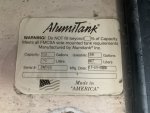Have I thought about putting tanks under the bed, yes. Probably won't though, for a couple of reasons.
I don't want things cantilevered out at the far end of the camper. It will be a lot of weight when loaded up (batts, water, gear, etc...) and while I think I have adequately spec'd its construction, I don't want to design in a load in that location. Right now, the only load that will be out there beyond the structure's own weight is our clothing, mattress, and us when we sleep. And whatever adventure gear we throw in the cargo bay (spare will also be mounted in the cargo bay but directly attached to the subframe and its load will not be borne by the camper frame).
I would prefer to keep the heavy stuff low for C of G reasons. Not that I will be out-cornering Ferraris and Corvettes in the camper but I don't want to roll it over when things get uneven. Water and batteries will be a considerable load (although truth be told, I haven't actually spec'd out either system in detail), and having them 3+ feet lower and between the chassis rails is appealing.
Right over the rear axles is where the 1088 was designed to carry weight. It makes sense to position my heaviest components in that space.
I will make a well insulated sub-floor space, but even so, I figure I will end up with some sort of tank wrap for when I am in storage and heater ducting for when we're out in it. I can live with that.
The current plan is for a composting toilet with a fallback of a cassette, so the objective is to not have a black tank. We have yet to commit to this but it is looking like we will.
We'll have a grey tank which will be easily accessible.
I don't want things cantilevered out at the far end of the camper. It will be a lot of weight when loaded up (batts, water, gear, etc...) and while I think I have adequately spec'd its construction, I don't want to design in a load in that location. Right now, the only load that will be out there beyond the structure's own weight is our clothing, mattress, and us when we sleep. And whatever adventure gear we throw in the cargo bay (spare will also be mounted in the cargo bay but directly attached to the subframe and its load will not be borne by the camper frame).
I would prefer to keep the heavy stuff low for C of G reasons. Not that I will be out-cornering Ferraris and Corvettes in the camper but I don't want to roll it over when things get uneven. Water and batteries will be a considerable load (although truth be told, I haven't actually spec'd out either system in detail), and having them 3+ feet lower and between the chassis rails is appealing.
Right over the rear axles is where the 1088 was designed to carry weight. It makes sense to position my heaviest components in that space.
I will make a well insulated sub-floor space, but even so, I figure I will end up with some sort of tank wrap for when I am in storage and heater ducting for when we're out in it. I can live with that.
The current plan is for a composting toilet with a fallback of a cassette, so the objective is to not have a black tank. We have yet to commit to this but it is looking like we will.
We'll have a grey tank which will be easily accessible.
Last edited:



